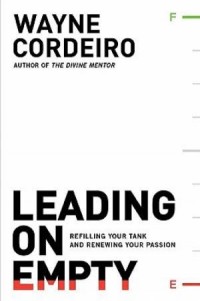Are You 'Leading On Empty'?
Jo Pountney
Feeling overwhelmed by the demands of ministry - Wayne Cordeiro felt that way too - his book offers hope.
Wayne Corderio begins his book with the line “We don’t forget that we are Christians. We forget that we are human…” Many of us in leadership can probably acknowledge feeling that way at one time or another.
Many leadership books deal with improving the way you lead, changing your leadership style or leading change – not many deal with what happens when you throw everything you have into leadership, sometimes at the expense of your own wellbeing, and then you hit rock bottom.
As with so many unwanted situations ‘burnout’ felt like it crept up on Corderio out of the blue, although in retrospect the signs had been there. ‘Leading on Empty’ is a very honest look at the place this mega church pastor found himself in and then it takes you on his journey in the hope that by, identifying the signs and incidents that led up to burnout, then posing ways to resolve the issues that arose in his own life, he can prevent others from reaching the place were they too are ‘leading on empty’.

Corderio uses a wonderfully insightful quote by the late Mother Teresa “To keep a lamp burning we have to keep putting oil in it.” This book chronicles, in a really honest way, the emotional and physical path that this church leader experienced, but alongside his biographical story is a wealth of practical advice.
The practical application of this book for anyone finding him or herself on the way to burnout becomes clear as soon as you start reading. But the book isn’t just for people reaching that point, it also deals with helping you avoid walking that path altogether. One of the key steps Corderio suggests is identifying what fills you with energy and what drains you. He encourages you to make a list, which in honesty I found more difficult than I initially imagined. But once you have the list and you start to know what re-energises you and what drains that energy, you can begin to work at ensuring that you do less of the things that run you down.
It would be great if we never had to do those things that absorb our energy at all, but the book acknowledges that the reality of leadership is sometimes those are part of the course. Having to do those things can be a necessity. Having a clear understanding of how to fill your energy tank back up is the key to getting through the really hard parts of leadership.
Corderio is real about how much leadership takes, that some elements of it aren’t what you expect, and that burnout can take anyone by surprise. His chapter about depression is a really helpful piece of writing for anyone who’s experienced it from the inside or has watched someone else go through it.
One of the great things about this book is that Corderio didn’t leave leadership – he went on to thrive in his position and found ways to deal with some of the really difficult parts of what it takes to lead well. It’s a book I’d recommend to leaders both in the church and in secular leadership or anyone who is considering leadership – some lessons are best learnt early and can make all the difference.
Latest Blogs

Gifts
Finding Your Symbol of Faith: A Guide to Christian Cross Necklaces
Looking for the perfect symbol of faith? Explore our guide to Christian cross necklaces, from rustic wooden designs and sturdy men's chains to elegant silver pendants.

Gifts
The Best Christian Gifts for Under £20
Looking for a meaningful gift that won't break the bank? Explore our guide to the best Christian gifts under £20, from inspiring journals to beautiful home decor.

Gift Guide
15 Confirmation Gift Ideas for Boys and Girls
Celebrating a confirmation? Discover 15 meaningful gift ideas for boys and girls, from youth Bibles and jewellery to inspiring journals and keepsakes.

Bible
30+ Powerful Quotes About the Bible (For Inspiration in 2026)
Looking for inspiration? Discover a curated collection of the most powerful quotes about the Bible, from famous historical figures to modern theologians and Scripture itself.

Bibles
What is the "Standard" Bible for Christians?
Is there an "official" Bible that all Christians use? We explain the difference between the NIV, KJV, and ESV, and help you find the standard text for your church or personal reading.

Bible
"I Keep Failing to Read the Bible" – 5 Tips to Make the Habit Stick
Do you start a Bible reading plan only to quit a few weeks later? Stop the cycle of guilt. Here are 5 psychological tips and practical changes to help you build a Bible habit that actually lasts in 2026.
